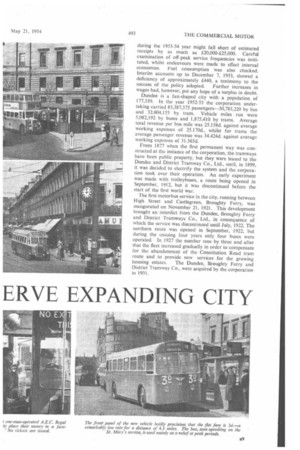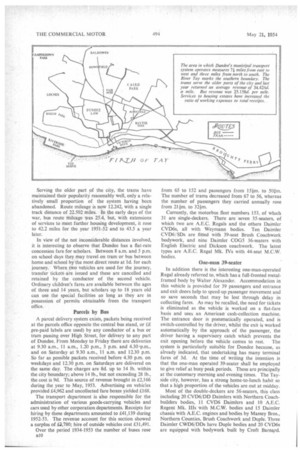DUNDEE BUS ERVE EXPANDING CITY
Page 42

Page 43

Page 44

Page 45

If you've noticed an error in this article please click here to report it so we can fix it.
THE 3d.-piece is a nimble coin in Dundee, that being among the reasons why the special one-manoperated bus, described in The Commercial Motor on April 9, is so well adapted to the situation. There are no fewer than 18 bus' and four tram termini to which the fare is 3d., distances in miles for the former being: Beechwood 3.38, Blackshade 4.63, St. Mary's 4.3, Mains Loan 3.17, Johnston Avenue 2.28 and 2.42, Craigiebank 2.38 and 2.56, Kingsway 3.66 and 2.49, Claverhouse 3.54, Kirkton 3.4, Mid Craigie 2.56, Douglas 3.3, Linlathen 2.6, Blackness 3.18, Fintry 3.16 and Camperdown 3.72; and for trams: Lochee 2.23, Ninewells 2.4, Blackness 2.22 and Downfield 3.16. From these figures it may be inferred that travel values are good in this Scottish city, and care is needed to make ends meet.
A certain degree of responsibility for social service to new housing estates has rested on the transport department, a fact which accounts for the rise, in recent years, of working expenses in ratio to total receipts. Up to the 'end of the war the highest these had reached was 87.4 per cent., but in 1947-48 they rose to 96.6 per cent. Reductions followed, but in 1950-51 the figure was up to 101.4 per cent., followed by 106.2 per cent. in the next year. In 1952-53 there was a drop to 100 per cent. Tramways, up from a ratio of 83.5 per cent., to 92.6 per cent. in 1946-47, touched 94.9 per cent. a year later, fell • to 82.8 per cent. in 1950-51 and rose to 89.98 per cent. o8 in 1952-53. As trams serve the older parts of the city their operational situation is basically different from that of the buses. In 1952-53 passengers per bus mile averaged 9.992 against 17.385 for the trams.
Some interest will attach to the results for the year which ended on May 15 this year. Increases in wages and materials influenced the transport committee to apply, in December, 1952, for a revision of fares. Authority for various modifications was granted on March 5, 1953, and the new rates were put into effect 10 days later. These were based on 0.66 of a mile for each stage, and gave 1-2 stages for 2d., 3-4 stages for 3d., 5-7 stages for 4d., 8-10 stages for 5d., and 11-13 stages for 6d., but also provided for ordinary terminal fares (excluding the Broughty Ferry, Barnhill and crosscity services) not exceeding 3d. Juvenile fares were fixed at Id. where the adult fare was 2d. and 2d. wherever it .exceeded this sum. Most concession tickets were withdrawn.
When the accounts for the year ended May 15, 1953, were published they showed a deficiency of £35,223, and it became clear to the management that revenue arising Serving the older part of the city, the trams have maintained their popularity reasonably well, only a relatively small proportion of the system having been abandoned. Route mileage is now 12.242, with a single track distance of 22.502 miles. In the early days of the war, bus route mileage was 25.4, but, with extensions of services to meet further housing development, it rose to 42.2 miles for the year 1951-52 and to 43.5 a year later.
In view of the not inconsiderable distances involved, it is interesting to observe that Dundee has a flat-rate concession fare for scholars. Between 8 a.m. and 5 p.m. on school days they may travel on tram or bus between home and school by the most direct route at Id. for each journey. Where two vehicles are used for the journey, transfer tickets are issued and these are cancelled and retained by the conductor of the second vehicle. Ordinary children's fares are available between the ages of three and 14 years, but scholars up to 18 years old can use the special facilities so long as they are in possession of permits obtainable from the transport office.
Parcels by Bus A parcel delivery system exists, packets being received at the parcels office opposite the central bus stand, or (if pre-paid labels are used) by any conductor of a bus or tram passing over High Street, for delivery to any part of Dundee. From Monday to Friday there are deliveries at 9.30 a.m., 11 a.m., 1.20 p.m., 3 p.m. and 4.30 tp.m., and on Saturday at 9.30 a.m., 11 a.m. and 12.30 p.m. So far as possible packets received before 4.30 p.m. on weekdays and 1130 p.m. on Saturdays are delivered on the same day. The charges are 8d. up to 14 lb. within the city boundary; above 14 lb., but not exceeding 28 lb., the cost is 9d. This source of revenue brought in £2,166 during the year to May, 1953. Advertising on vehicles provided £4,962 and uncollected fare boxes yielded £168.
The transport department is also responsible for the administration of various goods-carrying vehicles and cars used by other corporation departments. Receipts for hiring by these departments amounted to £41,139 during 1952-53. The revenue account for this section showed a surplus of £3,780; hire of outside vehicles cost £31,491.
Over the period 1934-1953 the number of buses rose 1 0 from 65 to 152 and passengers from 15i.m. to 50im. The number of trams decreased from 67 to 56, whereas the number of passengers they carried annually rose from 2lim. to 32im.
Currently, the motorbus fleet numbers 153, of which 31 are single-deckers. There are seven 35-seaters, of which two are A.E.C. Regals and the others Daimler CVD6s, all with Weymann bodies. Ten Daimler CVD6/SDs are fitted with 39-seat Brush Coachwork bodywork, and nine Daimler COGS 36-seaters with English Electric and Dickson coachwork. The latest types are A.E.C. Regal Mk. IVs with 44-seat M.C.W. bodies.
One-man 39-seater In addition there is the interesting one-man-operated Regal already referred to, which has a full-fronted metalframed body by Walter Alexander. Accommodation in this vehicle is provided for 39 passengers and entrance and exit doors help to speed-up passenger movement and so save seconds that may be lost through delay in collecting fares. As may be recalled, the need for tickets is eliminated as the vehicle is worked on a flat-fare basis and uses an Americancash-collection machine. The entrance door is pneumatically operated, and is switch-controlled by the driver, whilst the exit is worked automatically by the approach of the passenger, the driver having a supervisory catch which prevents the
exit opening before the vehicle comes to rest. The system is particularly suitable for Dundee because, as already indicated, that undertaking has many terminal fares of 3d. At the time of writing the intention is that the one-man operated 39-seater shall be employed to give relief at busy peak periods. These are principally at the customary morning and evening times. The Tayside city, however, has a strong home-to-lunch habit so that a high proportion of the vehicles are out at midday.
Most of the double-deckers are 56-seaters, this class including 20 CVD6/DD Daimlers with Northern Coachbuilders bodies, 11 CVD6 Daimlers and 10 A.E.C. Regent Mk. Ills with M.C.W. bodies and 15 Daimler chassis with A.E.C. engines and bodies by Massey Bros., Northern Counties, Brush Coachwork and Duple. Three Daimler CW136/13Ds have Duple bodies and 20 CVD6s are equipped with bodywork built by Croft Barnard. Elarnard bodies are also mounted on 12 A.E.C. Regent 111k. HI chassis. Other double-deckers include four Regent-M.C.W. 52-seaters, four Daimler C006s with 51-seat Dickson bodies, three Daimler COG6s with i2-seat Dickson bodies, nine Daimler COG6s with 51eat bodywork mainly by M.C.W., four Daimler COG6s fifth Cowieson 53-seat bodies and seven A.E.C. Regent Vl.k. Ills with 58-seat bodies. by Alexander.
In the early days, buses were parked in the open, but t new headquarters building eventually included a omposite depot, about two-thirds of which is allocated o motorbuses and the remainder to trams. First-line maintenance is carried out at well-lighted pits, and oil is aipplied from bulk containers. Oil-fuel hoses are hung mith the nozzles clear of the ground to avoid the possi)ility of contamination.
Maintenance by Time
Maintenance is carried out on a time basis equated to bout 1,000 miles running; this is known as Routine A. )etails of vehicles examined and adjusted in accordance vith this check are listed on an inspection sheet counterigned by the mechanic. There are 93 items on the sheet, 0 of which are concerned with the mechanical side, 16 rith electrical equipment, 14 with bodywork, one with fres and two miscellaneous. Spaces are provided for record of oil pressure, as well as for reports on the braking system and brake facings, the latter being subjected to an individual note for each wheel In hilly Dundee, facings run an average of approximately 10,000 miles.
Tyres are supplied under a maintenance contract shared equally by Goodyear and Dunlop. Tyre maintenance representatives check the condition of covers at the same time as the mechanical staff perform Routine A.
Big Range of Stores
As Dundee is some distance away from points where there are comprehensive supplies of spares, substantial stocks of all kinds are maintained in the stores. Excellent facilities exist for maintenance and overhaul work, a Hartridge test bench and an Octopus test cabinet being included in the equipment.
The Ultimate ticket-issuing system is employed. About 10 per cent, of takings is paid •into night safes, thus reducing the need for overtime on the part of the administrative staff. Conductors' boxes are lacked with individual keys which are placed in a key safe opened only at headquarters. All night-safe cash is counted in the mornings before a union nominee. In view of the economies that have been effected by this method in the course of its trial over three or four months, there is every likelihood of the procedure being extended.




















































































